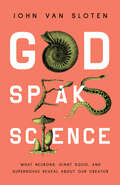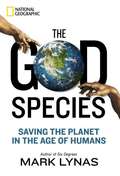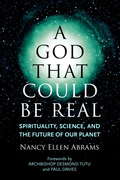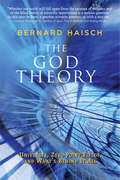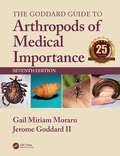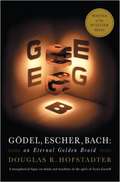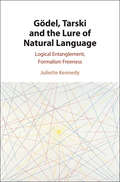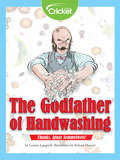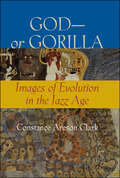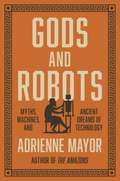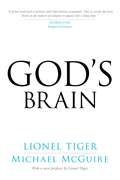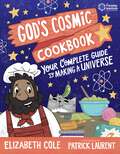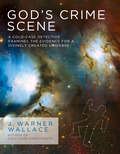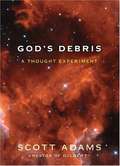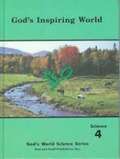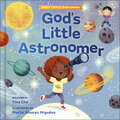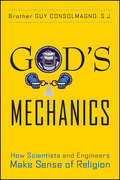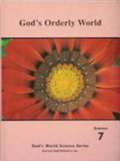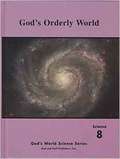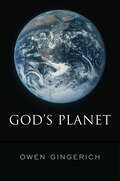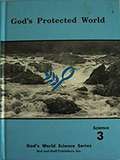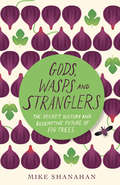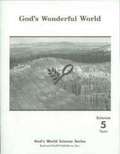- Table View
- List View
God Speaks Science: What Neurons, Giant Squid, and Supernovae Reveal About Our Creator
by John Van SlotenA joy-filled expedition into experiencing God&’s majestic, everywhere presence.DNA, the Danube River, and deep-sea life. Knees and trees. The Swiss Alps, songbirds, and supernovas. God speaks though His creation. And you don&’t have to be naturally gifted at biology, chemistry, or physics to be awakened to His wisdom and majesty. Pastor, teacher, and non-scientist John Van Sloten invites us to know God more deeply as we marvel at the complexities of His amazing creation.Knowing God through His written Word enables us to know Him more clearly through His creational Words. How does God speak through His creation, and what is He saying? Each chapter includes interviews with leading scientists and connects creation to its Creator. With the primary foundation that Jesus is the mediator of both salvation and creation, Van Sloten fields questions such as:Why are things beautiful and how can beautiful things be engaged?How does the doctrine of the Trinity teach us about the nature of tree branches and wound healing?What do the doctrines of creation, incarnation, and the resurrection tell us about phenomenon of supernovas?How do we engage God&’s providence through knees and fossils?We were made to wonder. To marvel. To know and live in awe of God. God Speaks Science expands our hearts and minds so that we might delight in the wisdom, beauty, and awesome power of our triune God!
The God Species
by Mark LynasWe humans are the God species, both the creators and destroyers of life on this planet. As we enter a new geological era - the Anthropocene - our collective power now overwhelms and dominates the major forces of nature. But from the water cycle to the circulation of nitrogen and carbon through the entire Earth system, we are coming dangerously close to destroying the planetary life-support systems that sustain us. In this controversial new book, Royal Society Science Books Prize winner Mark Lynas shows us how we must use our new mastery over nature to save the planet from ourselves. Taking forward the work of a brilliant new group of Earth-system scientists who have mapped out our real 'planetary boundaries', Lynas draws up a radical manifesto calling for the increased use of environmentally-friendly technologies like genetic engi- neering and nuclear power as part of a global effort to use humanity's best tools to protect and nurture the biosphere. Ecological limits are real, but economic limits are not, Lynas contends. We can and must feed a richer population of nine billion people in decades to come, whilst also respecting the nine planetary boundaries - from biodiversity to ocean acidification - now identified and quantified by scientists. Ripping up years of environmental orthodoxy, he reveals how the prescriptions of the current green movement are likely to hin- der as much as help our vitally-needed effort to use science and technology to play God and save the planet. From the Hardcover edition.
A God That Could Be Real
by Nancy Abrams Paul Davies Archbishop Desmond TutuA paradigm-shifting blend of science, religion, and philosophy for agnostic, spiritual-but-not-religious, and scientifically minded readers Many people are fed up with the way traditional religion alienates them: too easily it can perpetuate conflict, vilify science, and undermine reason. Nancy Abrams, a philosopher of science, lawyer, and lifelong atheist, is among them. And yet, when she turned to the recovery community to face a personal struggle, she found that imagining a higher power gave her a new freedom. Intellectually, this was quite surprising. Meanwhile her husband, famed astrophysicist Joel Primack, was helping create a new theory of the universe based on dark matter and dark energy, and Abrams was collaborating with him on two books that put the new scientific picture into a social and political context. She wondered, "Could anything actually exist in this strange new universe that is worthy of the name 'God?'" In A God That Could Be Real, Abrams explores a radically new way of thinking about God. She dismantles several common assumptions about God and shows why an omniscient, omnipotent God that created the universe and plans what happens is incompatible with science--but that this doesn't preclude a God that can comfort and empower us. Moving away from traditional arguments for God, Abrams finds something worthy of the name "God" in the new science of emergence: just as a complex ant hill emerges from the collective behavior of individually clueless ants, and just as the global economy emerges from the interactions of billions of individuals' choices, God, she argues, is an "emergent phenomenon" that arises from the staggering complexity of humanity's collective aspirations and is in dialogue with every individual. This God did not create the universe--it created the meaning of the universe. It's not universal--it's planetary. It can't change the world, but it helps us change the world. A God that could be real, Abrams shows us, is what humanity needs to inspire us to collectively cooperate to protect our warming planet and create a long-term civilization.From the Hardcover edition.
The God Theory: Universes, Zero-Point Fields and What's Behind it All
by Bernard HaischThe author, an astrophysicist, rejects dogmatic materialism and argues for the theory that an infinite consciousness is the underlying reality.
The God Theory: Universes, Zero-Point Fields, and What's Behind It All
by Bernard HaischOn the one hand, we have traditional science, based on the premises of materialism, reductionism, and randomness, with a belief that reality consists solely of matter and energy, that everything can be measured in the laboratory or observed by a telescope. If it can't, it doesn't exist. On the other hand, we have traditional religious dogma concerning God that fails to take into account evolution, a 4.6 billion-year-old Earth, and the conflicting claims of the world's religions. In The God Theory, Bernard Haisch discards both these worldviews and proposes a theory that provides purpose for our lives while at the same time is completely consistent with everything we have discovered about the universe and life on Earth. To wit, Newton was right -- there is a God -- and wrong -- this is not merely a material world. Haisch proposes that science will explain God and God will explain science. Consciousness is not a mere epiphenomenon of the brain; it is our connection to God, the source of all consciousness. Ultimately it is consciousness that creates matter and not vice versa. New discoveries in physics point to a background sea of quantum light underlying the universe. The God Theory offers a worldview that incorporates cutting-edge science and ancient mystical knowledge. This is nothing less than a revolution in our understanding.
The Goddard Guide to Arthropods of Medical Importance
by Gail Miriam Moraru Jerome Goddard IICovering all major arthropods of medical importance worldwide, this award-winning resource has established itself as a standard reference for almost 25 years. With the globilization of commerce and the world becoming more intimately connected through the everyday ease of travel, unknown arthropod species are being increasingly encountered. This means access to up-to-date, authoritative information in medical entomology has never been more important. Now in its seventh edition, this book maintains its well-acclaimed status as the ultimate easy-to-use guide to identify disease-carrying arthropods, the common signs and symptoms of vector-borne diseases, and the current recommended procedures for treatment. Includes an in-depth chapter with diagnostic aids to help physicians to recognize and accurately diagnose arthropod-related diseases and conditions more easilyUpdates all chapters with the latest medical and scientific findings, including Zika virus, red meat allergy, new viruses found in ticks, and vaccine development for malaria and dengue feverPresents a greater medical parasitology emphasis throughout Offers electronic downloads containing additional photographs of arthropod-caused diseases and lesions, as well as instructional videos with pest identification aids, basic entomology, and insect and pest ecology.Illustrated throughout with detailed color images to aid identification, The Goddard Guide to Arthropods of Medical Importance, Seventh Edition will remain an essential guide for physicians, public health officials, and pest control professionals.
Gödel, Escher, Bach: An Eternal Golden Braid
by Douglas R. HofstadterThis groundbreaking Pulitzer Prize-winning book sets the standard for interdisciplinary writing, exploring the patterns and symbols in the thinking of mathematician Kurt Gödel, artist M.C. Escher, and composer Johann Sebastian Bach.<P><P> Winner of the National Book Award<P> Pulitzer Prize Winner
Gödel, Tarski and the Lure of Natural Language: Logical Entanglement, Formalism Freeness
by Juliette KennedyIs mathematics 'entangled' with its various formalisations? Or are the central concepts of mathematics largely insensitive to formalisation, or 'formalism free'? What is the semantic point of view and how is it implemented in foundational practice? Does a given semantic framework always have an implicit syntax? Inspired by what she calls the 'natural language moves' of Gödel and Tarski, Juliette Kennedy considers what roles the concepts of 'entanglement' and 'formalism freeness' play in a range of logical settings, from computability and set theory to model theory and second order logic, to logicality, developing an entirely original philosophy of mathematics along the way. The treatment is historically, logically and set-theoretically rich, and topics such as naturalism and foundations receive their due, but now with a new twist.
The Godfather of Handwashing: Thanks, Ignaz Semmelweis!
by Leanne LongwillFind out how Ignaz Semmelweis was the first doctor to make the connection between hand washing and infection.
God—or Gorilla: Images of Evolution in the Jazz Age (Medicine, Science, and Religion in Historical Context)
by Constance A. ClarkAs scholars debate the most appropriate way to teach evolutionary theory, Constance Areson Clark provides an intriguing reflection on similar debates in the not-too-distant past. Set against the backdrop of the Jazz Age, God—or Gorilla explores the efforts of biologists to explain evolution to a confused and conflicted public during the 1920s. Focusing on the use of images and popularization, Clark shows how scientists and anti-evolutionists deployed schematics, cartoons, photographs, sculptures, and paintings to win the battle for public acceptance. She uses representative illustrations and popular media accounts of the struggle to reveal how concepts of evolutionary theory changed as they were presented to, and absorbed into, popular culture.Engagingly written and deftly argued, God—or Gorilla offers original insights into the role of images in communicating—and miscommunicating—scientific ideas to the lay public.
Gods and Robots: Myths, Machines, and Ancient Dreams of Technology
by Adrienne MayorThe fascinating untold story of how the ancients imagined robots and other forms of artificial life—and even invented real automated machinesThe first robot to walk the earth was a bronze giant called Talos. This wondrous machine was created not by MIT Robotics Lab, but by Hephaestus, the Greek god of invention. More than 2,500 years ago, long before medieval automata, and centuries before technology made self-moving devices possible, Greek mythology was exploring ideas about creating artificial life—and grappling with still-unresolved ethical concerns about biotechne, “life through craft.” In this compelling, richly illustrated book, Adrienne Mayor tells the fascinating story of how ancient Greek, Roman, Indian, and Chinese myths envisioned artificial life, automata, self-moving devices, and human enhancements—and how these visions relate to and reflect the ancient invention of real animated machines.As early as Homer, Greeks were imagining robotic servants, animated statues, and even ancient versions of Artificial Intelligence, while in Indian legend, Buddha’s precious relics were defended by robot warriors copied from Greco-Roman designs for real automata. Mythic automata appear in tales about Jason and the Argonauts, Medea, Daedalus, Prometheus, and Pandora, and many of these machines are described as being built with the same materials and methods that human artisans used to make tools and statues. And, indeed, many sophisticated animated devices were actually built in antiquity, reaching a climax with the creation of a host of automata in the ancient city of learning, Alexandria, the original Silicon Valley.A groundbreaking account of the earliest expressions of the timeless impulse to create artificial life, Gods and Robots reveals how some of today’s most advanced innovations in robotics and AI were foreshadowed in ancient myth—and how science has always been driven by imagination. This is mythology for the age of AI.
God's Brain
by Lionel Tiger Michael McGuireIn the fractious debate on the existence of God and the nature of religion, two distinguished authors radically alter the discussion. Taking a perspective rooted in evolutionary biology with a focus on brain science, the authors elucidate the perennial questions about religion: What is its purpose? How did it arise? What is its source? Why does every known culture have some form of it? Their answer is deceptively simple, yet at the same time highly complex: The brain creates religion and its varied concepts of God, and then in turn feeds on its creation to satisfy innate neurological and associated social needs. Brain science reveals that humans and other primates alike are afflicted by unavoidable sources of stress that the authors describe as "brainpain." To cope with this affliction people seek to "brainsoothe." We humans use religion and its social structures to induce brainsoothing as a relief for innate anxiety. How we do this is the subject of this groundbreaking book. In a concise, lively, accessible, and witty style, the authors combine zoom-lens vignettes of religious practices with discussions of the latest research on religion’s neurological effects on the brain. Among other topics, they consider religion’s role in providing positive socialization, its seeming obsession with regulating sex, creating an afterlife, how religion’s rules of behavior influence the law, the common biological scaffolding between nonhuman primates and humans and how this affects religion, a detailed look at brain chemistry and how it changes as a result of stress, and evidence that the palliative effects of religion on brain chemistry is not matched by nonreligious remedies. Concluding with a checklist offering readers a means to compute their own "brainsoothe score," this fascinating book provides key insights into the complexities of our brain and the role of religion, perhaps its most remarkable creation.
God’s Cosmic Cookbook
by Elizabeth ColeWith gentle humour and fun illustrations, this book confidently combines faith and science as God-the-chef helps readers navigate through the Big Bang, Inflation Theory, and getting to know your Goldilocks stars from your supermassive black holes. And that's not all! As you explore God's creative processes, you'll also see some of the beauty and complexity involved in getting things just right for life as we know it to unfold.This book has been created in partnership with The Faraday Institute for Science and Religion, Cambridge, UK. They have helped in every part of the process to ensure our science and theology are in line with current understandings and discoveries.
God's Crime Scene: A Cold-Case Detective Examines the Evidence for a Divinely Created Universe
by J. Warner WallaceThere are four ways to die, and only one of them requires an intruder. Suicides, accidental, and natural deaths can occur without any evidence from outside the room. But murders typically involve suspects external to the crime scene. If there's evidence of an outside intruder, homicide detectives have to prepare for a chase. Intruders turn death scenes into crime scenes. Join J. Warner Wallace, former atheist, seasoned cold-case detective, and popular national speaker as he tackles his most important case ... with you on the jury! With the expertise of a cold-case detective, J. Warner examines eight critical pieces of evidence in the "crime scene" of the universe to determine if they point to a Divine Intruder. If you have ever wondered if something (or someone) outside the natural realm created the universe and everything in it, this is the case for you.
God's Debris: A Thought Experiment
by Scott Adams"God's Debris" is a set of provocative questions (thought experiments) about God and science, wrapped in a fictional story. It is designed to inspire readers to question their views of reality.
God's Inspiring World: Science 4 (God's World Science Ser.)
by Lester Miller Barbara Schlabach Naomi Eicher Lapp Jonathan ShowalterAlso included are helpful suggestions for extra activities. Other lesson helps, such as the lesson guide and suggestions for class projects, are placed below the reduced pages. Copies of the tests with answers are included too.
God's Little Astronomer (God's Little Explorers)
by Tina ChoBlast off to space and discover how every part of the universe—the planets, the stars, asteroids, meteoroids, and more—display God&’s glory, creativity, and, most important, his love for you and me!&“An informative and inspirational bridge between science and religion for Christian households&”—Kirkus ReviewsIn God's Little Astronomer, author and educator Tina Cho invites young readers to blast off to see God&’s creation in the heavens. From the sun, moon, stars, constellations, and comets, this out-of-this-world introduction to space will teach budding astronomers new words, facts, and concepts, while also encouraging them to see God throughout the universe, and reinforcing the message that the same God loves them too.Each page includes fact-filled sidebars plus an accompanying Bible verse, making God's Little Astronomer the perfect combination of faith and science for budding scientists.
God's Mechanics: How Scientists and Engineers Make Sense of Religion
by Guy ConsolmagnoWith an &“adroit and self-effacing style,&” a Catholic brother, astronomer and physicist explains how scientists and engineers make sense of religion. In God's Mechanics, Brother Guy tells the stories of those who identify with the scientific mindset—so-called &“techies&”—while practicing religion. A self-decribed techie, astronomer, physicist and Director of the Vatican Observatory, Brother Guy shares some classic philosophical reflections, as well as his interviews with dozens of fellow techies, and his own personal take on his Catholic beliefs to provide, like a set of &“worked out sample problems,&” the hard data on the challenges and joys of embracing a life of faith as a techie. And he also gives a roadmap of the traps that can befall an unwary techie believer. With lively prose and wry humor, Brother Guy shows how he not only believes in God but gives religion an honored place alongside science in his life. This book offers an engaging look at how—and why—scientists and those with technological leanings can hold profound, &“unprovable&” religious beliefs while working in highly empirical fields. Through his own experience and interviews with other scientists and engineers who profess faith, Brother Guy explores how religious beliefs and practices make sense to those who are deeply rooted in the world of technology. &“Brother Guy Consolmagno speaks in the softest, sanest voice imaginable as he enters the current firestorm of opinion re science and religion. His engaging commentary exposes the mindset of a true &‘techie&’—but one who equates science with a sacred act.&” —Dava Sobel, author, Galileo&’s Daughter
God's Orderly World (God's World Science)
by Lester Showalter Peter BalholmGod's World Science Series
God's Planet
by Owen GingerichMany scientists look at the universe and conclude we are here by chance. The astronomer and historian Owen Gingerich looks at the same evidence--and the fact that the universe is comprehensible to our minds--and sees it as proof for the intentions of a Creator-God. The more rigorous science becomes, the more clearly God's handiwork can be understood.
God's Protected World: Science 3 (God's World Science)
by Lester Miller Naomi LappThis is the Student Edition from a set of 3rd grade science books by the Rod and Staff Publishers Inc. It has 7 units focusing on water, states of matter, seasons, temperature, humans, animals, and stewardship.
Gods, Wasps and Stranglers: The Secret History and Redemptive Future of Fig Trees
by Mike ShanahanThey are trees of life and trees of knowledge. They are wish-fulfillers ... rainforest royalty ... more precious than gold. They are the fig trees, and they have affected humanity in profound but little-known ways. Gods, Wasps and Stranglers tells their amazing story. Fig trees fed our pre-human ancestors, influenced diverse cultures and played key roles in the dawn of civilization. They feature in every major religion, starring alongside Adam and Eve, Krishna and Buddha, Jesus and Muhammad. This is no coincidence - fig trees are special. They evolved when giant dinosaurs still roamed and have been shaping our world ever since. These trees intrigued Aristotle and amazed Alexander the Great. They were instrumental in Kenya's struggle for independence and helped restore life after Krakatoa's catastrophic eruption. Egypt's Pharaohs hoped to meet fig trees in the afterlife and Queen Elizabeth II was asleep in one when she ascended the throne. And all because 80 million years ago these trees cut a curious deal with some tiny wasps. Thanks to this deal, figs sustain more species of birds and mammals than any other trees, making them vital to rainforests. In a time of falling trees and rising temperatures, their story offers hope. Ultimately, it's a story about humanity's relationship with nature. The story of the fig trees stretches back tens of millions of years, but it is as relevant to our future as it is to our past.
God's Wonderful World: Science 5 Tests
by Steven MastUnit tests for God's Wonderful World. 8 tests. Answers are found in the teacher's manual.
